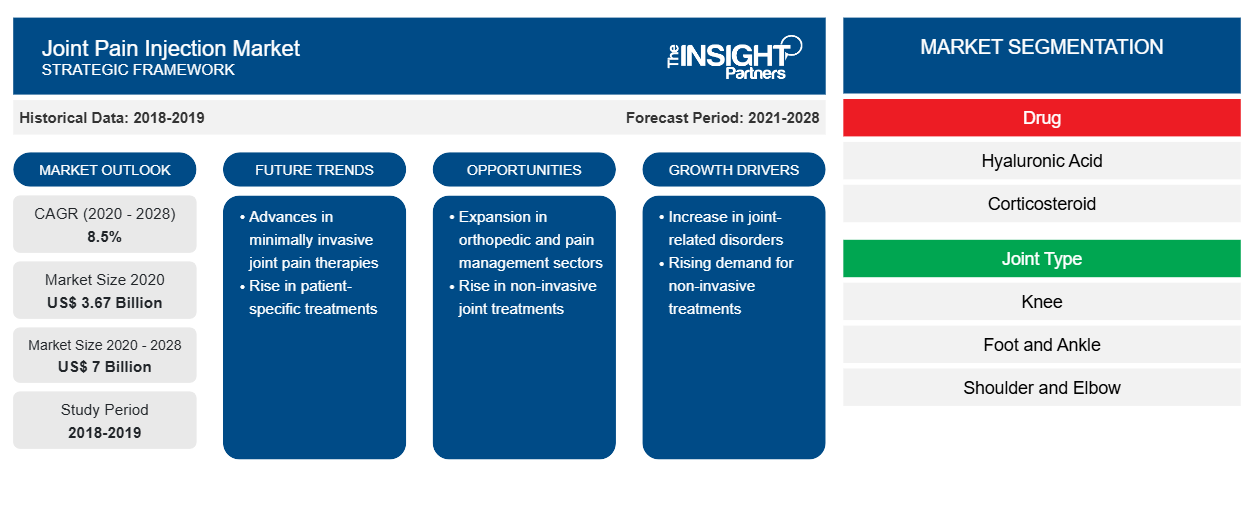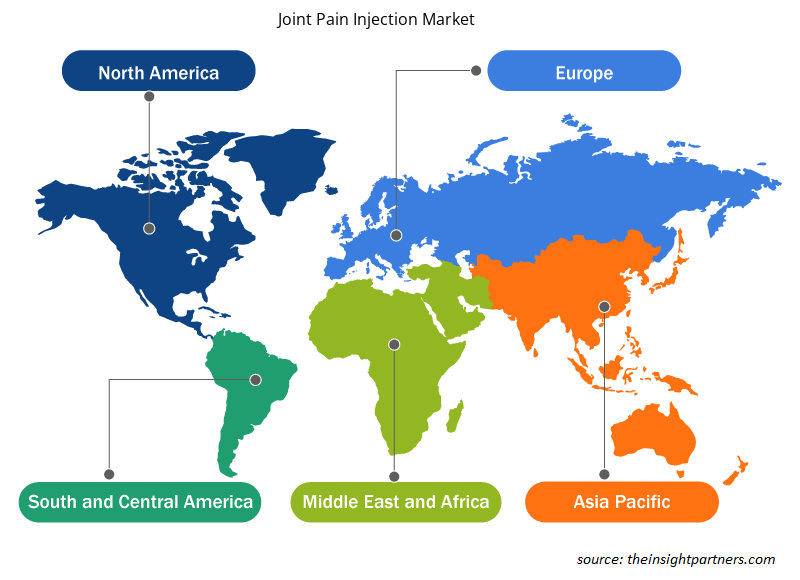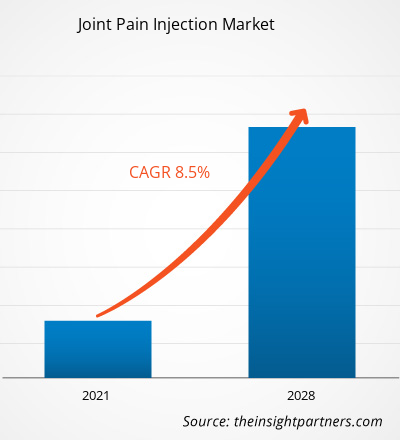[Research Report] The joint pain injection market is expected to reach US$ 6,996.88 million by 2028 from US$ 3,667.45 million in 2020; it is estimated to grow at a CAGR of 8.5% during 2021–2028.
Joint pain injections provide faster relief from severe pain and reduce inflammation of joints. Several types of injections available in the market include corticosteroids injections, hyaluronic acid (HA) injections, platelet-rich plasma (PRP) injections, and placental tissue matrix (PTM) injections. The growth of the joint pain injection market is attributed to the factors such as high prevalence of musculoskeletal disorders and increasing number of sports injuries. However, high costs of joint repair therapies hinder the market growth
Market Insights
High Prevalence of Musculoskeletal Disorders
Customize This Report To Suit Your Requirement
You will get customization on any report - free of charge - including parts of this report, or country-level analysis, Excel Data pack, as well as avail great offers and discounts for start-ups & universities
Joint Pain Injection Market: Strategic Insights

- Get Top Key Market Trends of this report.This FREE sample will include data analysis, ranging from market trends to estimates and forecasts.
You will get customization on any report - free of charge - including parts of this report, or country-level analysis, Excel Data pack, as well as avail great offers and discounts for start-ups & universities
Joint Pain Injection Market: Strategic Insights

- Get Top Key Market Trends of this report.This FREE sample will include data analysis, ranging from market trends to estimates and forecasts.
Musculoskeletal disorders are medical conditions affecting muscles, bones, and joints of neck, shoulders, wrists, back, hips, legs, knees, and feet. These diseases include tendinitis, carpal tunnel syndrome, osteoarthritis, rheumatoid arthritis (RA), fibromyalgia, and bone fractures. As per the World Health Organization (WHO) factsheet updated in 2018, musculoskeletal conditions are the second-largest contributor to disability worldwide. According to the same, the prevalence and impact of musculoskeletal disorders is expected to rise with the increase in aging population and rise in the prevalence of risk factors of noncommunicable diseases (NCDs) worldwide. As per 2016 American Academy of Orthopedic Surgeons’ annual meeting data, ~1 in 2 adults is suffering from a musculoskeletal disorder in the US. Further, according to the Centers for Disease Control and Prevention (CDC), arthritis causes severe pain that affects millions of people in the US every year. Around one in four arthritis patients, i.e., ~15 million of total ~54 million patients, experiences severe arthritis-related joint pain.
Further, osteoarthritis (OA) is one of the most common joint disorders in the US, caused by the breakdown of joint cartilage between bones. It is also known as degenerative joint disease or “wear and tear” arthritis. As per the Centers for Disease Control and Prevention (CDC), more than 32.5 million adults in the US suffer from osteoarthritis. Similarly, as per the National Health Service (NHS), more than 10 million people in the UK have arthritis or other similar conditions that affect joints. As per the Bupa Health Insurance, osteoarthritis is the most common form of arthritis prevalent in the UK, it affects around the one-third of people aged 45 or more in the country, i.e., ~8.75 million people. Therefore, such high prevalence of musculoskeletal disorders in different countries is increasing the number of treatment procedures being carried out for the same, thereby driving the joint pain injection market growth.
Drugs-Based Insights
The joint pain injection market, by drug, is segmented into hyaluronic acid, corticosteroid, and others. The corticosteroid segment held the largest share of the market in 2020, and it is further anticipated to register the highest CAGR during the forecast period.
Joint Type-based Insights
Based on joint type, the joint pain injection market is segmented into knee, foot and ankle, shoulder and elbow, hips, and other applications. The knee segment held the largest market share in 2020 and is anticipated to register the highest CAGR in the market during the forecast period.
Joint Pain Injection Market Regional Insights
The regional trends and factors influencing the Joint Pain Injection Market throughout the forecast period have been thoroughly explained by the analysts at The Insight Partners. This section also discusses Joint Pain Injection Market segments and geography across North America, Europe, Asia Pacific, Middle East and Africa, and South and Central America.

- Get the Regional Specific Data for Joint Pain Injection Market
Joint Pain Injection Market Report Scope
| Report Attribute | Details |
|---|---|
| Market size in 2020 | US$ 3.67 Billion |
| Market Size by 2028 | US$ 7 Billion |
| Global CAGR (2020 - 2028) | 8.5% |
| Historical Data | 2018-2019 |
| Forecast period | 2021-2028 |
| Segments Covered |
By Drug
|
| Regions and Countries Covered | North America
|
| Market leaders and key company profiles |
Joint Pain Injection Market Players Density: Understanding Its Impact on Business Dynamics
The Joint Pain Injection Market is growing rapidly, driven by increasing end-user demand due to factors such as evolving consumer preferences, technological advancements, and greater awareness of the product's benefits. As demand rises, businesses are expanding their offerings, innovating to meet consumer needs, and capitalizing on emerging trends, which further fuels market growth.
Market players density refers to the distribution of firms or companies operating within a particular market or industry. It indicates how many competitors (market players) are present in a given market space relative to its size or total market value.
Major Companies operating in the Joint Pain Injection Market are:
- Chugai Pharmaceutical Co., Ltd.
- Bioventus Inc.
- Fidia Pharma USA Inc.
- Flexion Therapeutics, Inc.
- SEIKAGAKU CORPORATION
Disclaimer: The companies listed above are not ranked in any particular order.

- Get the Joint Pain Injection Market top key players overview
Distribution Channel-based Insights
Based on distribution channel, the joint pain injection market is segmented into retail pharmacies, hospitals pharmacies, and others. The wound care segment held the largest market share in 2020, and the bone grafts segment is estimated to register the highest CAGR in the market during the forecast period.
Product launches and approvals are the commonly adopted strategies by companies to expand their global footprints and product portfolios. Moreover, the joint pain injection market players focus on the collaboration strategy to enlarge their clientele, which, in turn, permits them to maintain their brand name globally.
Joint Pain Injection Market – by Drug
- Hyaluronic Acid
- Corticosteroid
- Others
Joint Pain Injection Market – by Joint Type
- Knee
- Foot and Ankle
- Shoulder and Elbow
- Hip
- Others
Joint Pain Injection Market – by Distribution Channel
- Retail Pharmacies
- Hospitals Pharmacies
- Others
Joint Pain Injection Market – by Geography
North America
- US
- Canada
- Mexico
Europe
- France
- Germany
- Italy
- UK
- Spain
- Rest of Europe
Asia Pacific (APAC)
- China
- India
- South Korea
- Japan
- Australia
- Rest of Asia Pacific
Middle East and Africa (MEA)
- South Africa
- Saudi Arabia
- UAE
- Rest of Middle East and Africa
South and Central America (SCAM)
- Brazil
- Argentina
- Rest of South and Central America
Company Profiles
- Chugai Pharmaceutical Co., Ltd.
- Bioventus Inc.
- Fidia Pharma USA Inc.
- Flexion Therapeutics, Inc.
- SEIKAGAKU CORPORATION
- Ferring B.V.
- Sanofi
- Anika Therapeutics, Inc.
- Teva Pharmaceutical
- OrthogenRx, Inc.
Frequently Asked Questions
Who are the major players in the joint pain injection market?
The joint pain injection market majorly consists of the players such as Chugai Pharmaceutical Co., Ltd., Teva Pharmaceuticals, Bioventus Inc., Fidia Pharma USA Inc., Flexion Therapeutics, Inc., SEIKAGAKU CORPORATION, Ferring B.V., Sanofi, Anika Therapeutics, Inc., and OrthogenRx among others.
What are the driving factors for the joint pain injection market across the globe?
The global joint pain injection market growth is mainly attributed to factors such the high prevalence of musculoskeletal disorders and increasing number of sports injuries. However, the high costs of joint repair therapies hinder the market growth.
What are joint pain injections?
Joint pain injections are medicinal fluids inserted in the patient’s body to get faster relief from severe pain. The joint pain injections are used to reduce inflammation in the joints. There are several types of injections available in the market which are corticosteroids injections, hyaluronic acid (HA) injections, platelet-rich plasma (PRP) injections and placental tissue matrix (PTM) injections.
- Historical Analysis (2 Years), Base Year, Forecast (7 Years) with CAGR
- PEST and SWOT Analysis
- Market Size Value / Volume - Global, Regional, Country
- Industry and Competitive Landscape
- Excel Dataset
Testimonials
Reason to Buy
- Informed Decision-Making
- Understanding Market Dynamics
- Competitive Analysis
- Identifying Emerging Markets
- Customer Insights
- Market Forecasts
- Risk Mitigation
- Boosting Operational Efficiency
- Strategic Planning
- Investment Justification
- Tracking Industry Innovations
- Aligning with Regulatory Trends
Yes! We provide a free sample of the report, which includes Report Scope (Table of Contents), report structure, and selected insights to help you assess the value of the full report. Please click on the "Download Sample" button or contact us to receive your copy.
Absolutely — analyst assistance is part of the package. You can connect with our analyst post-purchase to clarify report insights, methodology or discuss how the findings apply to your business needs.
Once your order is successfully placed, you will receive a confirmation email along with your invoice.
• For published reports: You’ll receive access to the report within 4–6 working hours via a secured email sent to your email.
• For upcoming reports: Your order will be recorded as a pre-booking. Our team will share the estimated release date and keep you informed of any updates. As soon as the report is published, it will be delivered to your registered email.
We offer customization options to align the report with your specific objectives. Whether you need deeper insights into a particular region, industry segment, competitor analysis, or data cut, our research team can tailor the report accordingly. Please share your requirements with us, and we’ll be happy to provide a customized proposal or scope.
The report is available in either PDF format or as an Excel dataset, depending on the license you choose.
The PDF version provides the full analysis and visuals in a ready-to-read format. The Excel dataset includes all underlying data tables for easy manipulation and further analysis.
Please review the license options at checkout or contact us to confirm which formats are included with your purchase.
Our payment process is fully secure and PCI-DSS compliant.
We use trusted and encrypted payment gateways to ensure that all transactions are protected with industry-standard SSL encryption. Your payment details are never stored on our servers and are handled securely by certified third-party processors.
You can make your purchase with confidence, knowing your personal and financial information is safe with us.
Yes, we do offer special pricing for bulk purchases.
If you're interested in purchasing multiple reports, we’re happy to provide a customized bundle offer or volume-based discount tailored to your needs. Please contact our sales team with the list of reports you’re considering, and we’ll share a personalized quote.
Yes, absolutely.
Our team is available to help you make an informed decision. Whether you have questions about the report’s scope, methodology, customization options, or which license suits you best, we’re here to assist. Please reach out to us at sales@theinsightpartners.com, and one of our representatives will get in touch promptly.
Yes, a billing invoice will be automatically generated and sent to your registered email upon successful completion of your purchase.
If you need the invoice in a specific format or require additional details (such as company name, GST, or VAT information), feel free to contact us, and we’ll be happy to assist.
Yes, certainly.
If you encounter any difficulties accessing or receiving your report, our support team is ready to assist you. Simply reach out to us via email or live chat with your order information, and we’ll ensure the issue is resolved quickly so you can access your report without interruption.















The List of Companies - Joint Pain Injection Market
- Chugai Pharmaceutical Co., Ltd.
- Bioventus Inc.
- Fidia Pharma USA Inc.
- Flexion Therapeutics, Inc.
- SEIKAGAKU CORPORATION
- Ferring B.V.
- Sanofi
- Anika Therapeutics, Inc.
- Teva Pharmaceutical
- OrthogenRx, Inc.






 Get Free Sample For
Get Free Sample For